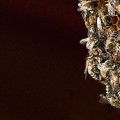Biofortification of vegetables with micronutrientsAn extra portion of zinc - von Prof. Dr Stephan Clemens
Powerful forearms, a pipe in the mouth, a sailor's hat: It takes him only seconds to open and empty the can of spinach. He faces his next brawl with superhuman strength. This is how we all know Popeye, the sailor. The secret of his strength is in the high iron content of spinach. This idea got innumerable parents to trying to get their children to “like” the rather unpopular vegetable. Unfortunately, some things are quite wrong here: While spinach...
 Extending the genetic systemCode Identified - von Prof. Dr Thomas Carell
The genetic code encodes all of the information that each cell requires to function and interact correctly with its environment. The code is constructed from four separate molecules, known as the “canonical” Watson-Crick bases, namely: adenine, cytosine, guanine and thymine. The genetic code arises from the sequence of these four bases – given as A, C, G and T – in the DNA double helix.
 HOBOS’ Prominent Patronessvon Dr Nizar Haddad, Princess Basma bint Ali
The story of HOBOS started with a successful book entitled “The Buzz about Bees” written by Prof. Dr. Jürgen Tautz in 2008. This unique book about the superorganism (the honey bee colony) was translated into 15 languages within one year. One of these languages was Arabic. It was translated by Dr. Nizar Haddad, a scientist from the Hashemite Kingdom of Jordan. The Arabic translation of the book won a prestigious award in applied and basic sciences....
 Learning from honeybees: live observation in the beehiveLight in the Darkness - von Prof. Dr Jürgen Tautz, Bernhard Schneider, Kristina Vonend
Inside a beehive it is warm – and utterly dark. The hive members function like a highly complex organism. Some 50,000 individuals live cheek-by-jowl and yet still have room to move. Thanks to the ingenious division of labour, it’s more a case of "busy as a hive" than "busy as a bee". Usually, what occurs in a beehive remains hidden from human view. Not so with HOBOS (HOneyBee Online Studies), the online research platform launched by our team....
 Nano Crystals for mega Fluorescence AmplificationSuperNova in the test tube - von Prof Dr Reinhard Renneberg, Jan Engels, Dr Hans-Georg Eisenwiener
We tell the exciting story of how mega fluorescence amplification was invented.
First, there was the question: How can previous biochemical evidence reactions be amplified million-fold to detect the biochemical “needles in a haystack” (substances at very low concentrations) in a multicomponent system like a blood sample?  Biowastes: a new feedstock for the chemicals industryValuable Waste - von Dr Mark Gronnow, Dr Margaret Smallwood
The chemicals industry has been wedded to fossil resources for the past hundred and fifty years, but times are a-changing. As the price of oil increases inexorably and environmental impact rises on the policy and regulatory agenda, industry leaders are starting to exploit new, more sustainable feedstocks for the manufacture of fuel and chemicals. Squarely in the frame as potential feedstocks are the vast tonnages of biowastes produced each...
 Extraction of the Double Helix
In the center of molecular biology is one species of molecules: DNA. DNA molecules are amplified and introduced into organisms by transformation or transfection, separated, stained, examined under the microscope, manipulated, sequenced and so on. For all these techniques the initial step is to isolate DNA from the origin of interest - and there is an endless number of DNA sources: soil, water, even air, body fluids (e.g. blood, sperm, and saliva),...
 labor&more in interview with prize-winning scientist Dr. Ben Lehner‘Luckily, Individuals Turn out to Be Different.’
Why are individuals different? Why do the same mutations in the genome have different effects on different individuals? Why does one twin get sick when another does not? How do sicknesses come about through the combination of different mutations? These are the questions which British scientist Dr Ben Lehner – ICREA Research Professor, EMBL-CRG Systems Biology Unit, at the Centre de Regulació Genòmica (CRG) in Barcelona – investigates in his...
 The earliest plasma marker for myocardial infarctionFabulous FABP - von Prof Dr Reinhard Renneberg, Prof. Dr Jan F.C. Glatz
The application of Fatty Acid-Binding Protein (FABP) as a plasma marker for the diagnosis of acute myocardial infarction was first suggested in 1988. Currently, FABP is proven to have added value for the diagnosis of patients presenting with chest pain suggestive of myocardial infarction, especially in the early hours after onset of symptoms. The routine application of FABP for this purpose not only will improve patient outcome but also markedly...
 Mysterious mycoplasma – a question of culture?!
Firstly reported in 1956 (Robinson et al. 1956), the potential presence of mycoplasma in cell culture laboratories challenges scientists. The parasitic mycoplasmas represent a serious problem for all cell line-related fields in research as well as in industrial facilities for development or manufacture of cell-derived biological and pharmaceutical products, including vaccines, monoclonal antibodies, drugs, and products for gene and cell therapy. Still,...
 New highly expandable platform for live cell imagingA Higher Level of Live Cell Research
Designed with the scientist’s workflow in mind the innovative new IX3 series of inverted research microscope systems from Olympus are developed for effortless, intuitive live cell imaging and clinical analysis. Built using worldwide customer feedback and designed to meet the needs of a wide range of users, the new systems offer exceptional ease-of-use and unprecedented optical flexibility via a new, customisable light path. New components can...
 The theory behind biological trace analysisA Spring Without Birdsong - von Prof. Dr Bernd Herrmann
In 1962, biologist Rachel Carson published her world-famous book “Silent Spring”, in which she warned of the consequences of inconsiderate use of DDT. DDT accumulates in the food chain and, thanks to its hormone-mimicking effects, causes serious damage to the organisms at the end of such food chains. One such effect is that the shells of many birds’ eggs become so thin that they break during incubation. The consequence: a silent spring without...
 |
|















